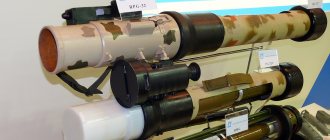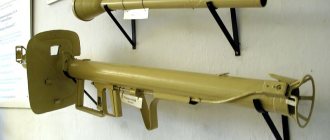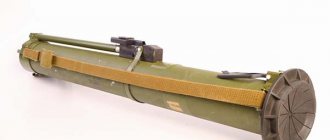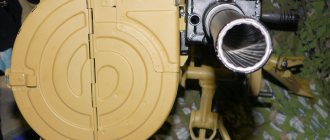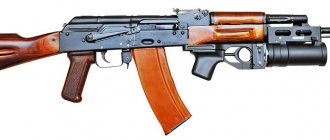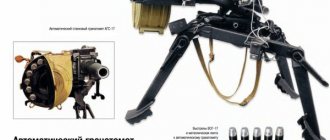"Partisan" mortar
After the creation of the Central (CSHPD) and Belarusian (BSHPD) headquarters of the partisan movement, operational directorates and departments appeared in their states that were engaged in studying the situation with the partisans’ armament and developing solutions to the identified problems. The maneuverable nature of the war, saturated with mobile equipment and engineering means, required new light and effective weapons for the partisans.
New types of ammunition
The attempts of the BSPD to obtain rifle grenades designed by Serdyuk for arming partisans were discussed in the previous part of our series. Despite what seemed to be the most obvious decision to modify the already finished ammunition, the question of additionally providing the partisans with special weapons remained open. The department of sabotage tactics and technology in the operational management of the Central Shpd first appeared in September 1942, but was liquidated less than two months after its creation as part of staff reductions. In May 1943, a division of sabotage tactics and equipment was created in the operational department of the Central Shpd. It was they who tried to formulate the tactical and technical requirements for the new guerrilla weapons.
The partisans are clarifying the operation plan belta.by
The designers were given the following tasks:
"1. Creation of new grenade samples, because... no similar drugs were known in terms of acceptability, purpose and effect.
Grenades should allow direct fire at a distance of up to 200 meters at moving and stationary targets. Distance throwing must be accurate enough and not reveal the shooter.
2. Creation of a means of throwing grenades by developing new or adapting existing weapon systems.
Grenades and means of throwing them must allow them to be dropped with a parachute, be light, compact, and always ready for action.”
To ensure the successful actions of the partisans, on the instructions of the BSPD and the head of the Bureau of Inventions of the People's Commissariat of Defense (NKO) of the USSR, in July 1943, KB-30 proactively began the development of a rifle incendiary grenade simultaneously with the development of a rifle anti-tank grenade.
And again Dyakonov's grenade launcher
The basic requirements for a grenade launcher were as follows:
"easy;
simple and easy to use;
should not be an independent, new type of weapon"
Considering that after 1917 only one grenade launcher designed by Dyakonov was adopted by the Red Army, the choice of the design bureau under the leadership of E.M. Viceni was very clear. With the advent of 50-mm mortars in the late 30s, the Dyakonov grenade launcher was removed from service, and its numerous reserves were in warehouses. The rifle grenade launcher consisted of a mortar mounted on the rifle barrel, as well as an aiming quadrant and bipod.
Dyakonov rifle grenade launcher kpopov.ru
For direct fire, neither a bipod nor special sighting devices were required. The modification of the mortar was reduced only to the appearance of a limiting screw and a new front sight, with the help of which aiming was carried out through the standard rear sight of the rifle. Although a version shortened by 90 mm was also tested, which only slightly worsened the ballistic characteristics of the grenade, while significantly increasing the rate of fire (from 4 to 7 rounds per minute). However, this option was never implemented, and the shooter only managed to fire one aimed shot at a target moving at a speed of 40 km/h from a distance of 150 m.
We also had to modify the propellant charge for the new grenade, which was a blank rifle cartridge. Options were tested with VT gunpowder charges weighing 3.3 g and P-45 weighing 2.56 g. VT gunpowder showed worse performance, and it was decided to use a P-45 gunpowder charge, but with a slightly increased weight of 2.75 g. Dulce such a cartridge was painted with black varnish (in contrast to the blank cartridge for the Serdyuk grenade with a red barrel color).
Cumulative grenade
The most universal ammunition for both partisans and conventional infantry was the cumulative action anti-tank grenade. It was this that aroused the greatest interest on the part of the Main Artillery Directorate (GAU), but let’s not forget that the impetus for its development was precisely partisan requirements:
“weight no more than 400 grams;
safety in handling;
allow storage in field conditions;
be always ready for action, simple and easy to use;
be simple and cheap to manufacture;
penetrate armor up to 50 mm thick and hit people with a high-explosive effect"
The anti-tank grenade consisted of a body, closed at the top with a fairing and at the bottom with a bottom nut, inside which there was a cumulating cup, an explosive and a bottom inertial fuse. On the body of the grenade there were three leading protrusions that fit into the rifling of the mortar. It was thanks to the rifled barrel that the grenade was given a rotational movement that stabilized it in flight.
This grenade made it possible to fight armored vehicles and stationary protected targets. The cumulative effect of the grenade made it possible to penetrate 50-60 mm of armor, which exceeded the armor-piercing value of anti-tank rifles, which were a special, heavy type of small arms.
The first tests of the VKG-40 took place at the Red Army Small Arms Research Site (NIPSVO KA) in November 1943. The grenade had a length of 136 mm, a mass of 205 g and an explosive weight of 80 g. TNT, as well as an alloy of TNT and hexogen (TG-50), were tested as an explosive. Various options for the thickness of the cumulative funnel with and without a central hole were considered. The best results were shown by grenades equipped with the TG-50 alloy, which had a cumulative funnel with a hole and a wall thickness of 0.8 mm - however, they also did not pass the tests. The main complaints concerned “low and unstable armor penetration, as well as non-failure-safe operation, due to the low sensitivity of the fuse”
.
VKG-40 cumulative grenade. Photo by the author
Subsequently, the grenade was modified several times and was tested in January, April and June 1944. The act of NIPSVO KA dated May 20, 1944 stated:
“The rifle cumulative grenade, due to its effective action, has withstood military tests and can be adopted into service with rifle units... Grenades can be introduced into service with a rifle squad, in the amount of 2-3 grenade launchers per squad.”
Soon the grenade was accepted for mass production and assigned the index 57-G-624. By Decree of the State Defense Committee (GOKO) No. 6727-ss of October 14, 1944, the VKG-40 anti-tank rifle grenade was adopted by the Red Army. For the fourth quarter of 1944, it was planned to convert 3,000 mortars, produce 200,000 blank cartridges and 150,000 grenades. The production of grenades was entrusted to factories No. 58 and No. 608 with their equipment at factory No. 11. For the first and second quarters of 1945, it was planned to produce another 150,000 and 180,000 grenades, respectively. Unfortunately, there is no data on the release of the VGK-40, as well as reliable information on their combat use.
"Electronic" grenade
However, the partisans were more interested in incendiary weapons for carrying out sabotage operations behind enemy lines. The task of developing such a grenade for partisans turned out to be more complex and non-trivial for designers. In addition to the general requirements for grenades, an incendiary grenade “must penetrate a board up to 50 mm thick at distances of 150-200 meters and reliably set fire to flammable materials (wooden structures, etc.)”
.
During the development process, several design options were tested, but in the end it was decided to use the “electron” alloy, which develops temperatures up to 3000-3500 ° C. Moreover, for reliable ignition of such an alloy, 50% of thermite equipment is needed, which reduces the useful weight of the grenade. By gradually heating the “electron” and bringing it to melting, it was possible to reduce this ratio to 20% of thermite.
The final equipped grenade is very simple in its design and consists of five parts: an “electron” body, thermite blocks, a plug, a KV-11 igniter primer and a powder moderator. The plug has four channels for force. Three pins are pressed onto the grenade body to fit into the rifling of the mortar and impart rotational motion in flight.
The amount of recoil when firing from a mortar with both cumulative and incendiary grenades is 30% higher than when firing with an ordinary rifle cartridge. However, it is within the limits acceptable for small arms.
VEZG-40 incendiary grenade. Photo by the author
The VEZG-40 grenade successfully passed field tests at NIPSVO KA in March 1944, and its drawings were approved by the technical department of the USSR NKB for production. In October, during the “Vystrel” course, military tests of rifle electronic incendiary grenades of the KB-30 design were carried out. VEZG-40 grenades passed the test and were recommended for arming the Red Army and partisans. Further plans included putting it into mass production, but by this time the Red Army had already completed the liberation of Soviet territory, which means the partisan movement was winding down. Sabotage weapons have lost their relevance.
Modernization
The development of the mortar and grenades was carried out by the designers of KB-30 L.I. Dovzhenko and A.N. Malinin. In November 1944, the mortar acquired a more convenient sight, located on the left side and consisting of two sights. The mounting option for the mortar has changed from threaded to latch. The VKG-40 grenade received a fuse with a self-destructive device. The VOG-40 fragmentation round also appeared, producing at least 180 fragments with an average weight of about 2.5 g each. The final conclusion of the field tests of the modernized system at NIPSVO KA dated December 16, 1944 notes the shortcomings necessary to refine the products, but with the requirement to carry them out for the 1944 model carbine.
In the same month, the GAU Artillery Committee formed new requirements for a rifle cumulative grenade with increased penetration (80-90 mm) and fragmentation (with a fragment killing radius of 20 m). Further development of the weapon continued for the carbine - this is another story about the VG-44 grenade launcher and the VPG-1 and VOG-1 grenades for it.
So, Dyakonov’s grenade launcher entered service for the third time in its history. This time he owed his return to the partisan struggle of the Soviet people against the German occupation. Despite the fact that the mortar itself did not undergo significant changes, in the BSPD documents it was referred to as the “Dovzhenko mortar”
.
As a result, neither the grenade launcher itself nor the grenades for it managed to get into service with the partisans. Nevertheless, the Dovzhenko mortar, anti-tank and incendiary grenades became an integral part of the history of the partisan movement during the Great Patriotic War. Characteristics of grenades
| Name | VKG-40 | VEZG-40 | VOG-40 |
| Caliber, mm | 40 | 40 | 40 |
| Length, mm | 144 | 115 | 100 |
| Weight, g | 220 | 200 | 220 |
| Explosive mass, g | 90 | 160 | 18 |
| Initial speed, m/s | 100-120 | 160 | n/a |
| Sighting range, m | 150 | 200 | n/a |
| Maximum flight range, m | 1000 | 1400-1500 | n/a |
Sources:
- TsAMO RF, fund 81, inventory 12040, file 125
- RGASPI, fund 644, inventory 2, file 403
- NARB, fund 1450, inventory 1, file 964
- Rifle anti-tank grenade VKG-40. Description
Acquaintance
The Dyakonov grenade launcher is a rifle weapon adapted for use from a closed position. With the help of fragmentation grenades fired from a grenade launcher, enemy personnel are destroyed, the location of which is equipped with firing points and field fortifications. Since these places are inaccessible to rifle units, the fire from which is carried out along a flat trajectory, you can eliminate the enemy using Dyakonov’s grenade launcher. Lightly armored targets are also subject to destruction. In this case, anti-tank grenades are used. Dyakonov's rifle grenade launcher and firing from it are intended not only for the physical destruction of the enemy. The weapon is also used as a means of warning, signaling and lighting.
About gun maintenance
The combat crew of a rifle grenade launcher is represented by two fighters: a gunner and a loader. The gunner’s task is to carry and install the gun, aim at the target and fire a shot, the loader’s task is to carry the combat kit to the Dyakonov grenade launcher. The number of grenades fired by one crew was up to 16 units. The loader also helped the gunner install and aim the mortar at the target, mount the remote tube and equip the gun with a projectile.
Due to the fact that shooting was accompanied by very noticeable recoil, it was not recommended to use the shoulder as a support for the rifle butt. Otherwise, the fighter could be left with a crushed collarbone. Therefore, the rifle was rested in the ground, in which a hole had previously been dug. During testing of the weapon, it was noticed that due to strong recoil, the butt could crack if stone or frozen ground was used as a support for it. Therefore, in winter, in order to prevent the butt from breaking, a special pad was placed under it. During loading, the shutter must be left in the open position. This measure prevented unplanned shooting.
Creation
On March 8, 1916, the staff captain of the 37th Yekaterinburg Regiment, M. G. Dyakonov, who had previously trained at the Military Automobile School, was seconded to the rifle range of the Officer Rifle School “to demonstrate his inventions.” Dyakonov created a rifle grenade that was fired from the barrel of a rifled mortar of his design.
The Dyakonov mortar was intended to be mounted on the muzzle of a Mosin rifle of the 1891 model. The mortar's barrel was made of a seamless steel pipe and had a caliber of 40.5 mm. They even managed to put the mortar and grenade into service, but did not have time to put it into production, since on March 1, 1918, all work was curtailed due to the “demobilization of industry.”
In the 1920s, the grenade launcher designed by Dyakonov was tested again, the grenade was modernized in order to increase the firing range and was eventually adopted by the Red Army in 1928 by decision of the Revolutionary Military Council of the USSR dated February 8, 1928. The first order (for 1929) for the production of grenades amounted to 560 thousand pieces and cost 5 million rubles (about 9 rubles for one grenade).
Tactical and technical characteristics of the grenade
- The ammunition of the Dyakonov system, caliber 40.6 mm and length 11.7 cm, weighed no more than 360 g.
- The mass of the warhead was 50 g.
- When the grenade exploded, 350 pieces of fragments were formed.
- The lethal radius of the projectile reached 350 m.
- The grenades moved towards the target at a speed of 54 m/s. With additional charges, they covered 110 m within one second.
What is the advantage of a grenade launcher?
The strengths of this weapon are that it could be used to eliminate the enemy in a well-fortified shelter. It is impossible to do this with small arms due to its flat trajectory. In addition, the grenade launcher was adapted to fire rifle cartridges. The fighter did not need to remove the mortar for this.
Grenade launchers of the Dyakonov system were used in the Soviet-Finnish War, and later in the Great Patriotic War. In 1945, these guns were removed from service with the Soviet Army.
About tactical and technical characteristics
- The weapons of the Dyakonov system are of the type of rifle grenade launchers.
- Country of origin: USSR.
- The grenade launcher was used by the Red Army from 1928 to 1945.
- When fully assembled (with bipod, rifle and mortar), the grenade launcher weighs up to 8.2 kg.
- The mass of the mortar was 1.3 kg.
- The barrel is equipped with three rifling with a pitch length of 672 mm.
- The combat crew consists of two people.
- The target range varies from 150 to 850 m.
- Firing from a grenade launcher ensures hitting a target at a distance of up to 300 m. With the presence of an additional charge, the distance increased to 850 m.
- Within one minute, from 5 to 8 shots can be fired from this weapon.
About the design
The Dyakonov grenade launcher was a muzzle-loading system. This product was also called a mortar, which, together with a bipod, a bayonet and a quadrant protractor, was equipped with a 7.62 mm rifle. The design of the mortar included the following parts:
- The body, which is represented directly by a rifled barrel. The existing three grooves were intended for the leading protrusions of the grenade.
- Cup.
- Neck. This element was equipped with a special shaped cutout, thanks to which the cup could be attached to the barrel like a bayonet.
The grenade launcher used a threaded connection to attach parts. In an effort to give the rifle stability during operation at various angles, it was equipped with a bipod. When the grenade launcher was installed, the legs of the bipod with their sharp ends were stuck into a hard surface. A clip was attached to the bipod stand and a rifle unit was inserted into it. It was possible to attach the clip using a clamp at different heights. The rifle grenade launcher was aimed using a quadrant goniometer. To install the protractor, a special clamp was used, the left side of which served as a place for the quadrant box, and the right side for the protractor and sight line. Using a quadrant, the elevation angle was verified when aiming vertically, and a protractor - in the horizontal plane. In 1932, a special manual was published describing the design of the Dyakonov grenade launcher. The manual also contained information about the characteristics and combat capabilities of ammunition for the weapon of this system, the rules for their storage and operation.
About the disadvantages
According to military experts, with the introduction of the Dyakonov system grenade launcher into service, the Red Army soldiers became the owners of a weapon that was quite effective in the First World War. Mortars are most effective for positional battles. For a “mobile” war, experts are convinced, these grenade launchers are practically useless. Dyakonov's grenades and grenade launchers could be considered ideal only in 1917. In 1928 they were already outdated, and by the beginning of the Great Patriotic War they were completely outdated. The disadvantage of the system was that the preparation was too complex:
- Before firing a projectile, the grenade launcher estimated the distance to the target by eye.
- Next, from memory or using a special table, the gunner had to determine in what position the sight should be, set at a particular range.
- Then it was necessary to calculate how long it would take for the spacer tube to burn. In this case, the grenade had to hit the target with the maximum number of fragments. This is possible if it explodes directly above the target itself.
- Insert the grenade into the barrel.
The preparation was too complex, which negatively affected the rate of fire.

